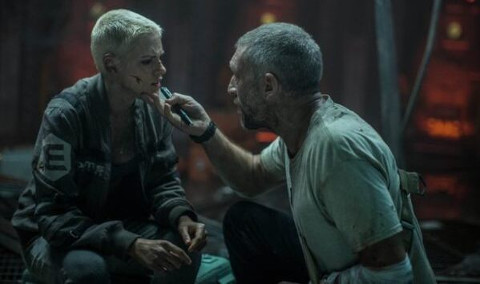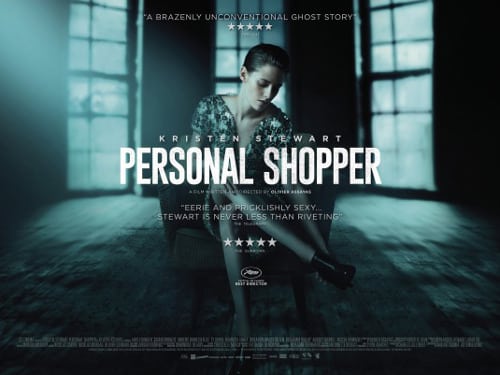Underwater (2020)
Directed by: William Eubank
Written by: Adam Cozad, Brian Duffield
Starring: Jessica Henwick, Kristen Stewart, T.J.Miller, Vincent Cassel
USA
IN CINEMAS NOW
RUNNING TIME: 95 mins
REVIEWED BY: Dr Lenera, Official HCF Critic
In the depths of the Mariana Trench, a drilling company is pushing their way into the center of the Earth, constructing a massive structure home to technicians and rig workers. When an earthquake destroys most of the site, electrical engineer Norah Price and fellow crew member Rodrigo Nagenda barely escape with their lives. After they’ve found four other survivors, the group tries to find their way to a livable area, but it seems that there are other living beings around, and they don’t seem to be friendly….
I was actually quite glad that Underwater came along when it did. Seeing as I found 47 Metres Down to be a very decent exercise in suspense, I was looking forward to seeing its sequel in the cinema, but then the UK distributors decided to release it straight to digital and DVD [not even a Blu-ray] for reasons that I can’t fathom, seeing as its predecessor did rather well at the box office. But along came Underwater to hopefully satisfy my nautical terror urge. This was actually shot just under three years ago, which may lead one to believe that it’s a dog, though the Disney purchasing of 20th Century Fox was probably more a cause of the holdup. In fact Underwater, which I gather has garnered mixed reviews, isn’t bad at all, and should satisfy those who wax nostalgic for the days when ‘B’ movies of its type with rather larger budgets than ‘B’ movies ought to have were very common on our cinema screens. Many will be making understandable comparisons to Alien, though it seems to me that the major templates were Life, Deep Star Six and The Abyss, though thankfully Underwater is a better movie all round than the first of those three films, even if it certainly has its issues, chiefly in terms of the screenplay and the way that it’s shot. Yes folks, this is another film in which it’s hard to make out what’s happening in places because the camera is shaking all over the place, something that’s especially stupid when the action is being set near the bottom of the sea where visibility is already not that great. You’d have thought that director William Eubank would have realised this. But let’s not get too negative. There’s still a lot to enjoy in this lean, no-nonsense piece which just ploughs ahead and gets on with it, and there are moments where it actually gets a little scary – and I don’t mean the typical ‘build up to BOO moment followed by BOO moment’ schtick that’s being done to death these days – though there are certainly two or three good jump scares.
So Titan Industries intends to drill seven miles to the bottom of the Mariana Trench for resources. An impressively lengthy opening shot tracks under water to the Kepler 822 Station- and yes, this film doesn’t have any land footage whatsoever, a good decision I think because it really adds to the feeling of claustrophobia and isolation. More nice long takes take us past the corridors of the station and some possibly post-added narration by our heroine, Norah, tells us how time starts to lose all meaning when you’re that far underwater, that there’s no light and that you sometimes can’t even tell if you’re awake or dreaming. Then suddenly a large earthquake hits, and it really is sudden as things switch to being extremely kinetic as Norah flees for her life with the camera with her all the way, the only instance where the shaky camera technique adds to the proceedings. It’s so well done that it’s only afterwards when one realises how ludicrous some of this is. There’s no way that a human being would be able to withstand this underwater structure imploding, and in fact the whole thing would have most likely been destroyed. “Science was never my strong point” said a certain James Bond villain when showing off his deadly weapon to 007, and it isn’t mine either, but even I noticed this. Oh well – it’s only a movie. Norah and another crew member Rodrigo are able to escape the area and close it off, temporarily preventing further damage to the Kepler. As they make their way to the escape pod bay, they then rescue another guy named Paul who’s trapped, then soon find that Captain Lucien, Emily Haversham and Liam Smith have also survived.
There’s little attempt at characterisation – there’s just no time – and this actually seemed good to me after the terribly forced introductions of the characters in Life, though I could have done with just slightly more than stuff such as – Liam is in love with Emily, Paul clings to a stuffed animal for comfort, and the Captain doesn’t really know what he’s doing as the head of the drilling project. Norah’s backstory clumsily comes out about three quarters of the way through, though as some one with a soft spot for the disaster movies of the ’70s I can’t say that I minded this. It’s daft though that all the of crew members except one seem to be rather mentally and/or emotionally incapacitated, meaning that they would have never been accepted into doing this job in the first place! I suppose we’re intended to think that they are this way due to being where they are for so long, but this doesn’t really come through. Anyway, Norah and co. are unsuccessful in their attempts to make contact with the surface, so Lucien recommends that they put on pressurised suits and walk one mile across the ocean floor to the Roebuck Station 641. They emerge from the station into a cargo elevator, but the helmet of one of their number is faulty and cracks from the pressure, killing this person instantly. The surviving crew see a distress beacon from one of the escape pods below, and Smith and Paul go outside to investigate, but the pod has been ripped open and a body lies in the rubble. To be honest I’d have been reasonably content if there had been no science-fiction or horror elements at all, because I was quite gripped. But instead we suddenly get a shock moment clearly modeled on a certain iconic scene, and now things are different. At one point Emily says how what they’re doing is bad, hinting at the possibility that this previously undiscovered species of aquatic life is just defending its territory against mankind which seems hell bent on destroying this planet, but this is never followed through until right at the end. For the most part, there’s no attempt at messaging at all – and actually it’s rather great!
While there’s some time spent in stations which seem to be virtually all sets as opposed to CGI, many of the big set pieces take place on or near the sea bed, but it’s here where the hectic camerawork tends to take over, resulting in an incoherent mess much of the time where if you blink you’ll miss what has happened to somebody. I know I often whinge at this style of film-making, partly because I often feel psychically sick when watching it, but at least in things like the Fast And Furious movies the mayhem is usually set on land during the day. Here, while the ‘vomit-cam’ isn’t as wild as in some movies, the fact that things are dark and blurry makes trying to follow what’s going on very hard indeed in places. That being said, at least the cutting isn’t as eye-hurtingly fast as it could have been, the large usage of close-ups during some of the walking/swimming scenes is another thing that increases the claustrophobic atmosphere along with very loud heavy breathing, and it does actually feel like we are underwater. They actually shot all the undersea scenes on a stage with no lights, which sounds like hell for the cast members. Maybe this was because of all that water digitally added afterwards, but the creatures are fairly convincing as these things go, even though it’s disappointing that they still seem to be riffing on the same old monster designs, you’ll recognise the inspirations as soon as you get your first major view of one of the creatures. They do provide a few genuinely frightening moments though, and Eubank has said something very interesting about the final creature that we see which ties in with the recent craze for adapting one of my favourite horror writers. But the plot doesn’t really provide much in the way of surprises, and one feels that they could have made a bit more of an effort to develop things, though it’s a formula that still sort of works so I guess it doesn’t matter that much really.
Eubank’s 2014 film The Signal [following his debut Love which I haven’t seen] got widely divisive reactions. I thought it to be a stupid mess that showed little promise. Underwater does reveal him to be fairly capable of helming a more conventional, ‘popcorn’-type movie. Now Kristen Stewart still seems to get criticised a great deal for her performances, and maybe a bit unfairly. Perhaps the hangover from Twilight is too strong, but Robert Pattinson, who was just as bad in that series, tends to be widely praised these days [and quite rightly so], and there’s no way that Woody Allen would have picked her to be in one of his films if he hadn’t have seen something in her acting. She can sometimes seem a bit lacking in emotion, as is the case here, but then one can also see that Norah could possibly be holding back any feelings as a way to deal with all the things that are happening. She does do the gutsy female lead act pretty well, while the always worthwhile Vincent Cassel provides probably the best of the supporting roles as Lucien. T.J. Miller’s Paul though seems to have been intended as comedy relief, but is instead an annoyance who’s never anywhere near as funny as the script thinks he is and who you end up just wanting to be killed off. Nonetheless, the cast do have a chemistry together and are able to show character traits by the way their character react to or do certain things. And it’s believable that, rather than bicker, these people just want to make it out of there alive and therefore devote all their energies to getting on with the job.
Underwater ends in a manner that seems to introduce a new element into the story. This might have really worked if we’d had some build-up to it, but I guess screenwriters Brian Duffield and Adam Cozad were most interested in creating something that might lead to a sequel which will expand the film’s world. There’s some potential for this as quite a lot is left vague, but I don’t think it will happen now anyway, and I do wonder if going for an ‘R’ rating rather than a ‘PG-13’ would have been a good idea as this film often seems like it’s literally gagging to get really gruesome but is held back from doing so. In any case, it unashamedly tries to be nothing more than schlocky fun, and, while certainly not coming close to the charms of the likes of Deep Blue Sea and Deep Rising in the opinion of this critic, I wouldn’t be surprised if it does become more popular when released onto home viewing. You might even be able to properly make out what’s going on in some scenes if you play them at half speed.










Be the first to comment